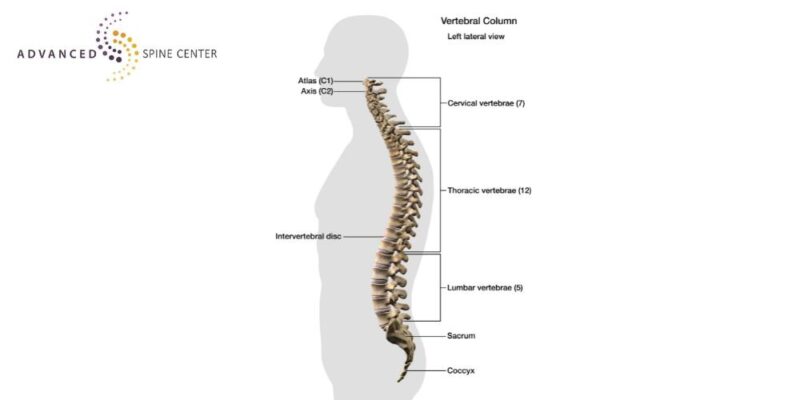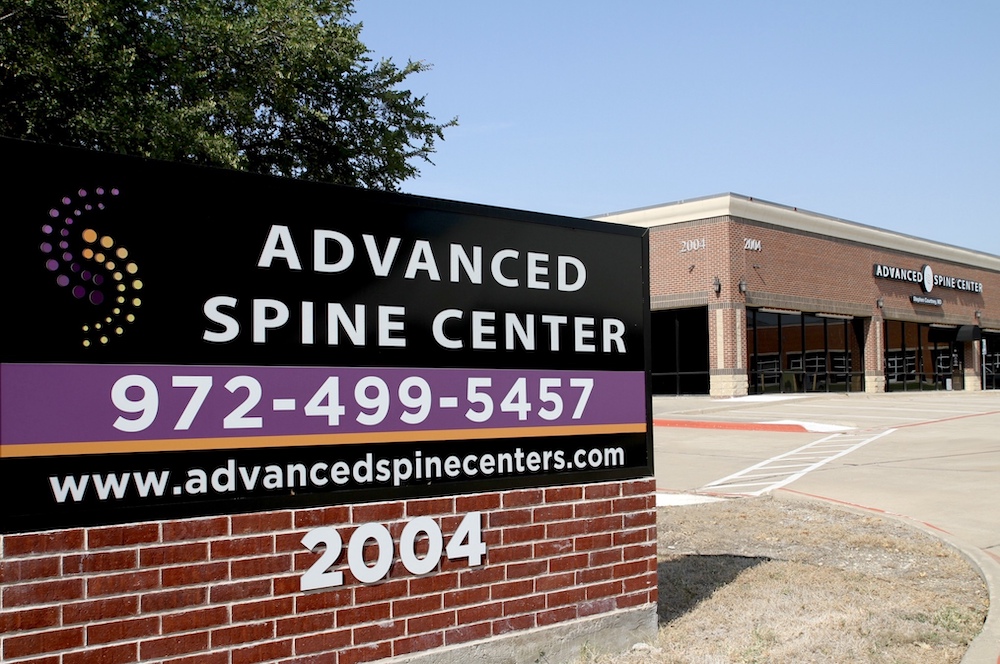Specialties
Lumbar Fusion Surgeon in Plano, TX
Damage to your spine, whether from wear and tear or trauma, can cause severe pain and disability that requires lumbar fusion surgery. When you need the best care for your lower back, see Stephen Courtney, MD, at Advanced Spine Center for lumbar fusion surgery in Plano, TX.
Based in Plano, Texas, since 1995, Dr. Courtney is a skilled orthopedic spine surgeon who offers personalized and precise lumbar fusion procedures. Learn more about lumbar fusion by calling 972-499-5457 or scheduling a consultation with Dr. Courtney online today.
Lumbar Spine Anatomy

The lumbar spine includes 5 spinal vertebrae located in the lower back, labeled L1 through L5. These are the largest of all the vertebrae in the spine. They are noticeably larger and thicker than the other vertebrae, as they provide stability for the back and spinal column.
The lumbar spine is essential in the body’s overall structure and function. It supports the upper body, allows for a wide range of movements, and helps maintain an upright posture. Additionally, the lumbar vertebrae protect the spinal cord, which is a very important part of the central nervous system.
Due to its importance and the substantial amount of weight it bears, the lumbar spine is a common site for various orthopedic issues and back problems, such as herniated discs, spinal stenosis, and muscle strains. Proper posture, regular exercise, and ergonomic practices are crucial for maintaining the health and function of the lumbar spine.
What Is Lumbar Fusion?
Lumbar fusion is a surgical procedure used to stabilize vertebrae in the spine to ease pain and discomfort. During lumbar fusion surgery, Dr. Courtney makes a small incision in your back to access the bones of your spine. Lumbar spine fusion occurs when a surgeon fuses two or more vertebrae from the lumbar spine together.
The goal is to have the fused vertebrae grow together into one bone. While this can reduce one’s range of motion, it is highly effective at relieving pain caused by conditions such as fractured spinal bones, spondylolisthesis, and degenerative disc disease.
Using X-ray technology to guide the procedure, he removes damaged discs from the spine and replaces them with surgical cages filled with donor bone. These cages maintain the space between each vertebra and can relieve pressure on irritated tissues, including nerves. The cages are attached to the spine using a surgical plate and screws to provide long-term stability.
When Is Lumbar Fusion Recommended?
The primary goal of this procedure is to alleviate pain, improve spinal stability, and address certain spinal conditions or injuries that have not responded to non-surgical treatments. Dr. Courtney offers as many conservative and minimally invasive treatment options as possible, though he can recommend surgery if other measures haven’t worked for you.
Generally, fusion is considered if certain movements are the source of the patient’s pain. Dr. Courtney determines if you’re a candidate for surgery based on your symptoms and diagnosis, a thorough orthopedic exam, and imaging, including X-rays and an MRI.
What Conditions Can Lumbar Spinal Fusion Surgery Treat?

Lumbar spinal fusion surgery can be used to treat a variety of spinal conditions and problems in the lower back (lumbar spine). Conditions that can benefit from lumbar fusion include:
- Degenerative disc disease
- Degenerative joint disease
- Arthritis
- Spinal tumors
- Spinal instability
- Herniated discs
- Degenerative spine disease
- Spondylolisthesis
- Lumbar radiculopathy
- Sciatica
- Scoliosis
- Fractured vertebrae
What Types of Lumbar Fusion Surgeries Are Available?
Dr. Courtney performs traditional open fusion surgeries, minimally invasive transforaminal lumbar interbody fusions (TLIF), and 360° lumbar fusions. While open surgery involves a larger incision than minimally invasive surgery, it could be the best option for you based on your specific situation.
Minimally invasive TLIF involves a small incision in your back directly above the damaged vertebral segment. Dr. Courtney uses X-rays to guide the surgery and places a series of dilators into the incision site to gently pull the surrounding muscles away from the surgical site. Due to the smaller incision, there’s less risk of infection, and you usually heal faster than after open surgery.
A 360° fusion involves surgically fusing both the front and back of the vertebral segment for increased stability. Dr. Courtney could recommend this for some conditions or as revision surgery. It can be done as open or minimally invasive surgery, depending on your needs.
In the following sections, we outline the various types of lumbar spinal fusion surgeries.
Traditional Open Lumbar Fusion
Ideally, surgeons want to use minimally invasive techniques for surgeries. However, certain situations warrant open surgery. Open surgery involves a significantly larger incision and the dissection of the spinal muscles. It can also lead to more postoperative pain and longer recovery times.
Anterior Lumbar Interbody Fusion (LIF)
In an anterior spinal fusion, the surgeon approaches the spine from an incision at the front of the stomach. All tissues between the incision site and the spine must be dissected or moved aside. “Interbody” means treating an area between two bordering vertebrae.
Posterior Lumbar Interbody Fusion (LIF)
In a posterior fusion, the surgeon approaches the spine from behind the lumbar spine. The surgeon removes the damaged spinal disc. Then, they proceed with the process of fusing two or more vertebrae. In some cases, the fusion will be followed up or supplemented with a posterolateral spine fusion surgery.
Posterior Spinal Fusion and Posterolateral Fusion (PLF)
In this procedure, the surgeon makes an incision on the middle of the lower back to access the lumbar vertebrae. They will also separate the muscles. This technique involves using a bone graft between the affected vertebrae.
360° Lumbar Fusion
Also known as anterior/posterior lumbar fusion, this technique allows for limited muscle dissection, which makes it less invasive than other techniques. In fact, 360° lumbar spinal fusion is considered one of the most successful techniques for spinal fusion.
How to Prepare for Lumbar Spinal Fusion Surgery

Before the surgery, the patient is evaluated through imaging studies like X-rays, CT scans, or MRIs to identify the exact location and nature of the spinal problem. Your doctor will perform a health exam to discern your candidacy for lumbar fusion.
At least 7-10 days before the surgery, you should stop taking any medications that thin the blood. This includes blood thinners, aspirin, ibuprofen, vitamin E, and other medications. Be sure to inform your doctor of all medications, supplements, and herbs you currently take. They may ask that you stop taking certain medications.
Refrain from smoking and drinking alcohol before or after your surgery. Alcohol and nicotine can hinder the healing process and lead to bleeding problems. It is best to stop drinking and smoking at least one week before your surgery, but preferably earlier.
Prepare your home for your recovery before the surgery. Move all your essential items to an easily reachable location so you won’t have to bend down or reach up for them. Remove all trip hazards. Prepare meals ahead of time. Drink plenty of water and eat high-fiber foods to avoid constipation problems.
You will remain in the hospital for 2-3 days after surgery. Once you are ready to go home, ensure that you have someone who can help you during your first few days of at-home recovery. Having someone support you during early recovery can greatly decrease the likelihood of complications.
What to Expect from Lumbar Spinal Fusion
First, a healthcare provider will check and confirm your medical history, current medications, and your emergency contacts. You will meet your anesthesiologist, who will discuss the surgery with you. You will then meet with your surgeon. They will confirm that you have signed a consent form, and then mark the surgery site.
The exact steps of lumbar spinal fusion vary depending on the vertebrae to be fused, as well as the type of fusion. Other important procedural information includes the following.
Anesthesia: The patient is placed under general anesthesia, which means they are unconscious and feel no pain during the surgery.
Surgical Approach: There are different surgical approaches to lumbar spinal fusion, and the specific approach used depends on the patient’s condition and the surgeon’s preference. Common approaches include the following.
- Posterior Fusion: The surgeon makes an incision in the back and accesses the spine from the rear.
- Anterior Fusion: The surgeon approaches the spine from the front through an abdominal incision.
- Lateral Fusion: The surgeon accesses the spine from the side.
- Oblique Fusion: The surgeon accesses the spine from the side, but does not divide the psoas muscle.
Bone Graft: The surgeon will decide between an implant or bone graft depending on the patient’s needs. To encourage fusion, bone graft material is placed between the vertebrae that need to be fused. The bone graft can come from the patient’s own body (autograft), a donor (allograft) at a bone bank, or synthetic materials.
Instrumentation: In some cases, hardware such as screws, rods, or cages may hold the vertebrae in the desired position while fusion occurs. This hardware provides additional stability during the healing process.
Fusion Process: Over time, the body naturally fuses the adjacent vertebrae together. This can take several months, during which the bone graft material stimulates new bone growth, effectively “fusing” the vertebrae into a single, stable structure.
Is Lumbar Fusion a Major Surgery?
Yes, lumbar spine surgery is considered a major surgery. It is used to treat serious back problems and injuries affecting the lumbar spine. A surgeon will likely use rods, screws, and a bone graft to stabilize the spine. In most cases, spinal fusion is saved as a last resort after more conservative treatment methods have failed.
What Is Recovery Like After Lumbar Spinal Fusions?

Because the surgery is performed under general anesthesia, you should not feel any pain or have any memory of the procedure. After the surgery, patients usually stay in the hospital for 2 or 3 days. Once you go home, you’ll spend the first couple of weeks resting in bed.
You will likely be prescribed pain medicine to relieve any postoperative pain. Over time, your pain should improve and decrease the necessity of pain medication. Once a few weeks have passed, you can gradually increase your activities of daily living. Be sure to follow your doctor’s instructions during this period.
After the surgery, patients typically need a period of rehabilitation and physical therapy to regain strength, mobility, and function. The length of recovery can vary depending on the extent of the surgery and individual factors.
How Long Does It Take to Recover from Lumbar Fusion?
Lumbar spine fusion is a major procedure that has a fairly lengthy recovery period. The body’s natural healing process varies from person to person. However, most patients can expect a full recovery around 6 months after the surgery. It is incredibly important to follow your doctor’s instructions to ensure proper bone healing and recovery.
What Is the Success Rate of Lumbar Spinal Fusion Surgery?
The success rate of lumbar spinal fusion varies depending on the surgical approach and the condition treated. However, the estimated rate of success is around 70-90%. Other factors that can influence the success of the procedure include your health, source of pain, and the specific surgery.
What Are the Permanent Restrictions After Lumbar Fusion?
In many cases, patients lose some mobility in their lumbar spine after lumbar spine fusion. This loss of mobility can restrict patients from participating in certain activities. The amount of mobility loss largely depends on how many vertebrae are fused.
For example, a patient who has two fused vertebrae will have lost less mobility than a patient who has four fused vertebrae. Some patients who undergo multi-level fusions may lose the ability to bend over to pick up items from the floor.
The best way to understand the potential restrictions is to consult with a skilled Plano orthopedic spine surgeon.
Potential Complications and Risks of Lumbar Fusion
It’s important to note that while lumbar spinal fusion can be an effective treatment for certain spinal conditions, it is not without risks, and the decision to undergo this surgery should be carefully considered after consulting with a spine specialist. Additionally, not all back pain or spinal issues require fusion surgery, and non-surgical treatments are often explored as the first line of care.
If you and your doctor have determined that surgery is the right choice, it’s important to understand the potential complications. While complications are rare, they can include the following.
- Damage to spinal nerves or spinal cord
- Infection of surgical site
- Pain at bone graft site
- Damaged blood vessels or excessive bleeding
- Pseudoarthrosis development
- Blood clots
- Leaking spinal fluid
Contact the Advanced Spine Center for Lumbar Fusion in Plano, TX
You’ve been living with lower back pain and activity restrictions for long enough. It’s time to take back control of your life and eliminate your chronic back pain. Lumbar fusion could be the lower back pain solution you need. To find out if surgery is right for you, contact the Advanced Spine Center by calling 972-499-5457 or booking an appointment online now.
Dr. Courtney also offers cervical spinal fusion, cervical injections, lumbar injections, and lumbar microdiscectomy for back pain.


